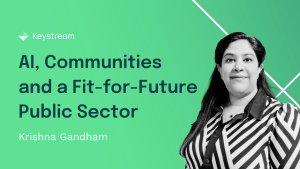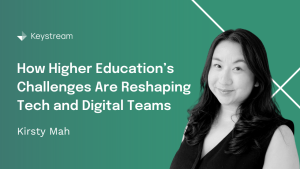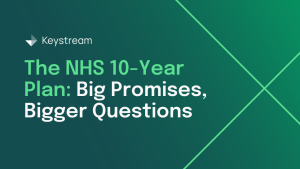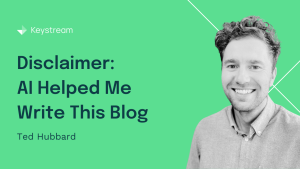22.07.2025
AI, Communities and a Fit-for-Future Public Sector
Navigating a New Vision for Health and Local Services
The government’s 10-Year Plan for the NHS lays out a bold vision of a “fit for the future” health service, with three major shifts: care closer to home, digital-first services, and a focus on prevention. It is a plan to reimagine how care is delivered by harnessing technology and innovation, from AI-enabled hospitals to empowered community care teams. Crucially, this is not just an NHS plan; it is a whole-system reform that calls for coordination with local government and other partners. Local authorities are themselves undergoing huge transformation, merging services under new devolution deals and driving greater digital enablement of public services. The challenge now is turning this vision into real-world results – connecting NHS services, councils, and technology in a way that genuinely improves people’s lives.
From my perspective, the answer lies in safely harnessing data and AI to serve our communities. The opportunity is immense: done right, AI can help children grow up healthier, support working-age adults with smarter services, and help older people live independently. But turning big promises into real change means focusing on two things: getting the basics right and innovating responsibly.
Getting the Basics Right with Machine Learning
Digital transformation starts with fixing the fundamentals: clean data, consistent processes, and visibility across services. Before thinking about robot surgeons or chatbots, public sector teams need to get these right – and that’s where machine learning (ML) can already help.
In a recent NHS project, our team used ML to analyse thousands of outpatient letters and predict which follow-up pathways could be safely closed. In just two weeks, the model achieved 77% accuracy and flagged 4,000 open referrals (approx. 10%) as potentially closable. That means clearer demand visibility and a chance to reduce waiting lists by safely concluding unnecessary pathways. In other words, smart use of data can help unclog the system and redirect resources to patients who need them most.
This kind of back-to-basics AI doesn’t make headlines like a humanoid robot might, but it creates real value. ML can spot inefficiencies, flag risks, automate classifications, and support staff in routine tasks. Many councils and health providers are sitting on years of data – a goldmine of insights if we apply the right algorithms. By uncovering actionable insights such as which repair requests might escalate or which appointments are likely to be missed, ML helps public services work smarter. These small, targeted wins build momentum for bigger change.
From Analogue to Digital – and Beyond to AI Innovation
Both the NHS plan and local government strategies emphasise moving “from analogue to digital.” This means getting rid of paper-based processes and siloed legacy systems in favour of connected, user-friendly digital tools. We have seen this need first-hand. In one large Trust formed by multiple mergers, fragmented document systems were causing unnecessary costs, integration issues, and compliance risks. A digital discovery uncovered clear opportunities to consolidate systems, reducing complexity and laying the groundwork for a unified, future-ready EPR (Electronic Patient Record). In a separate regional programme, we supported efforts to bring structure and consistency to a core operational function, payroll, across multiple organisations. The shift to a tiered, centralised model aimed to simplify workflows, clarify accountability, and create a more scalable foundation for future digital automation. What both cases highlight is that digital transformation is not just about technology. It is about untangling complexity, aligning teams around common processes, and creating the space to adopt new tools with confidence.
With solid digital foundations in place, public sector leaders can start to explore AI for more creative problem-solving and ideas generation. This goes beyond automating current workflows – it is about imagining new ways to deliver services. Here, the public sector can benefit from the experimentation common in the private sector. For instance, tech companies use AI-driven simulations to test ideas or generate designs; cities and hospitals could do the same to reimagine care pathways or resource allocation. Generative AI tools (used with the right guardrails) might help brainstorm solutions to, possibly, improve childhood obesity rates or design age-friendly public spaces, by rapidly prototyping what might work best in a given community. The key is to bring the innovative spirit of the private sector into public service, while anchoring it in the public sector’s mission of equity and social value. We should encourage cross-pollination.
Safe, Ethical and Effective: AI We Can Trust
Amid all the excitement about AI, one thing matters most: safety. Innovation means little if people (staff and residents alike) don’t trust the technology.
As Health Secretary Wes Streeting recently said, the UK aims to lead in “responsible AI innovation in healthcare.” That ambition only works if new tools are introduced with care, backed by evidence and clear ethical guardrails. Lawrence Tallon of the MHRA put it well: “AI has huge promise… but only if people can trust that it works and is safe.”
Building that trust takes more than regulation. It means rigorous testing (through initiatives like the MHRA’s “sandbox” for AI in medical devices), transparent validation of results, and strong governance around data privacy and bias.
For public sector leaders, ‘safe use of AI’ is not just a regulatory box to tick, it is essential to public confidence. Communities need to know that tools like AI triage systems or council chatbots support professional judgment, not replace it. This means involving clinicians, social workers, and frontline staff in design and deployment, making sure outputs are explainable and auditable, and being clear about where AI helps – and where a human touch is still vital.
In our work, we often start by helping organisations define the problem and consider whether AI is even the right tool. Sometimes a better process or cleaner data delivers more value than a flashy algorithm. By staying focused on outcomes, public services can avoid the trap of ‘AI hype’ and build change that’s both safe and meaningful.
Collaboration to Help Communities Thrive
Ultimately, using AI to serve our communities is about collaboration – across sectors and across professional boundaries. The NHS 10-year plan explicitly calls for working in partnership with local government, tech companies, and community organisations to improve the nation’s health. This resonates strongly with us. We have seen that the most successful digital transformations bring together diverse voices: healthcare managers and data scientists, council officials and startup innovators, clinicians and patients. When these perspectives unite around a common goal, you create a solution that is technically sound and grounded in real-world needs.
The coming years will test whether lofty strategies can translate into tangible improvements in people’s lives. There will be pressures such as tight budgets, workforce constraints, and the sheer complexity of change. But there are also more reasons for optimism than ever. If we combine the best of the private sector’s agility with the public sector’s purpose, we can deliver services that truly help people thrive from childhood to old age. Whether it is an AI that helps midwives spot risks earlier or a predictive model that helps a council target support to vulnerable elderly residents, the impact can be profound, if done right.
Now is the time for action.
For operational and digital leaders in the NHS and local government, this means asking: Where could data or AI ease a bottleneck or spark a new approach in my organisation? Perhaps it is exploring automation in a back-office process, or using analytics to proactively prevent a crisis. My advice is to start small but start now – experiment safely, learn quickly, and scale what works. At Keystream, we are excited to support this journey. We have helped teams lay digital foundations and prove AI concepts with minimal risk, always with an eye on building internal capability.
If you are curious about what is possible – whether it is leveraging machine learning to get your basics right, or brainstorming how AI might enable a new service model, get in contact. The 10-Year Plan has set the destination. Together, we can navigate the path to get there, ensuring that new technology genuinely improves lives in our communities.



